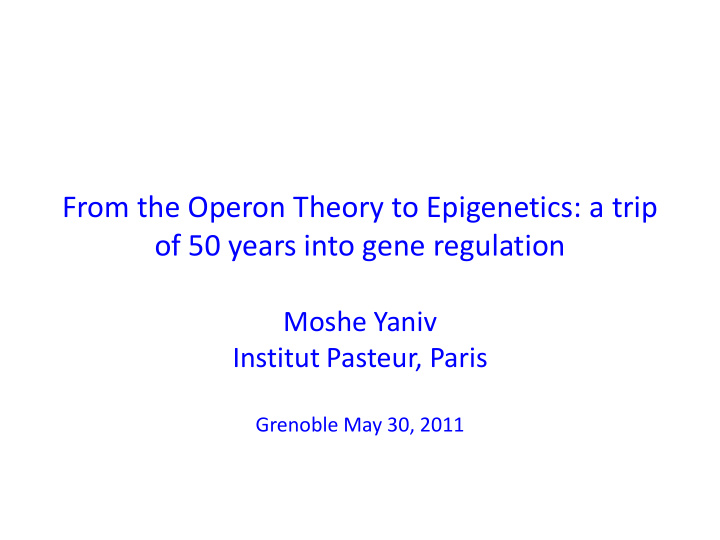



From the Operon Theory to Epigenetics: a trip of 50 years into gene regulation Moshe Yaniv Institut Pasteur, Paris Grenoble May 30, 2011
Kinetics of Fos proteins induction
Complexity of transription regulation in eucaryotes • Multiplicity of transcription factors (positive and negative) binding to promoters and enhancers controled by signal transduction pathways and covalent modifications • Multiplicity of general cofactors • Histone and DNA modifications machineries recruited by TFs • Chromatin remodeling machines
The Histone Code, Chromatin Remodeling and Transcription • Overcoming nucleosome repression • The histone code: modifiers, erasers and readers • Chromatin remodeling complexes • Polycomb and trithorax gene products
DNA methylation, a post replication mark 5’ -ATATTGCGAATTGGCCTTATGGCCTATACCGAAAT TATAACGCTTAACCGGAATACCGGATATGGCTTTA C = Cytosine méthylable
CpG methylation and gene activity A.Bird, JMB, 2011
Cross talk between CpG and methyl CpG recognition & histone modifications
EPIGENETICS Gene expression states that are stable over rounds of cell division, but do not involve changes in the underlying DNA sequence of the organism • Development and differentiation (epigenesis) Maintenance of : - gene repression /activation - repeat silencing Multiple Epigenomes One Genome E. Heard (Institut Curie)
What is epigenetics and why is it important? • Epigenetics: heritable (and reversible) changes in gene activity that do not entail DNA sequence changes • Epigenetics plays essential roles in development and disease • Epigenetics contributes to heritable phenotypic variation E. Heard (Institut Curie)
Clear examples of epigentic somatic cell transmission • Random inactivation of one of the two X chromosomes in female cells • parental imprinting of genes • Gene silencing by DNA methylation in cancer
The epigenetic landscape Epigenetics : the branch of biology which studies the causal interactions between genes and their products which bring the phenotype into being. Conrad Waddington, 1942
The paradox of induced stem cells (iPSCs): or are all processes just dictated by the equilibrium of TFs present in the cell? • Introduction of four tTFs: Oct4, Sox2, Klf4 & cMyc reprogrammes somatic cells into iPSCs, however: • Process is slow and non efficient • Parental imprinting is not maintained • Reduced potential for implantation
What is next? • Can we predict the repertoire of genes driven by a given TF(s) ? • Can we predict the signaling pathways that affect the activity of a TF? • Can we predict the rates of transcription? • Can we identify the wirings which control transcription and cell specificity in development? • Can we predict the cascade involved in iPSC formation?
Recommend
More recommend